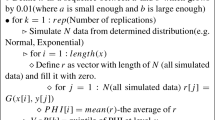Abstract
This paper further studies the single-period portfolio allocation of risk assets under the assumption that random returns having increasing utility and Archimedean copula. The shares of risk assets in the optimal allocation are proved to be ordered when marginal returns have the likelihood ratio order, and sufficient conditions for the joint density of returns of a multivariate risk to be arrangement increasing is built as well.

Similar content being viewed by others
References
Ali, M. M., Mikhail, N. N., & Haq, M. S. (1978). A class of bivariate distributions including the bivariate logistic. Journal of Multivariate Analysis, 8, 405–412.
Boland, P. J., Proschan, F., & Tong, Y. L. (1988). Moment and geometric probability inequalities arising from arrangement increasing functions. The Annals of Probability, 16, 407–413.
Chen, Z., & Hu, T. (2008). Asset proportions in optimal portfolios with dependent default risks. Insurance: Mathematics and Economics, 43, 223–226.
Cheung, K. C. (2006). Optimal portfolio problem with unknown dependency structure. Insurance: Mathematics and Economics, 38, 167–175.
Cheung, K. C., & Yang, H. (2004). Ordering optimal proportions in the asset allocation problem with dependent default risks. Insurance: Mathematics and Economics, 35, 595–609.
Denuit, M., Dhaene, J., Goovaerts, M., & Kaas, R. (2005). Actuarial theory for dependent risks. New York: Wiley.
Genest, C., & MacKay, J. (1986a). The joy of copulas: Bivariate distributions with uniform marginals. American Statistician, 40, 280–283.
Genest, C., & MacKay, R. J. (1986b). Copules archimédiennes et familles de lois bidimensionnelles dont les marges sont données. Canadian Journal of Statistics, 14, 145–159.
Genest, C., & Rivest, L. P. (1993). Statistical inference procedures for bivariate Archimedean copulae. Journal of the American Statistical Association, 88, 1034–1043.
Hennessy, D. A., & Lapan, H. E. (2002). The use of Archimedean copulas to model portfolio allocations. Mathematical Finance, 12, 143–154.
Hollander, M., Proschan, F., & Sethuraman, J. (1977). Functions decreasing in transportation and their application in ranking problems. The Annals of Statistics, 5, 722–733.
Hua, L., & Cheung, K. C. (2008). Stochastic orders of scalar products with applications. Insurance: Mathematics and Economics, 42, 865–872.
Joe, H. (1997). Multivariate models and dependence concepts. London: Chapman & Hall.
Kijima, M., & Ohnishi, M. (1996). Portfolio selection problems via the bivariate characterization of stochastic dominance relations. Mathematical Finance, 6, 237–277.
Kimberling, C. H. (1974). A probabilistic interpretation of complete monotonicity. Aequationes Mathematicae, 10, 152–164.
Lapan, H. E., & Hennessy, D. A. (2002). Symmetry and order in the portfolio allocation problem. Economic Theory, 19, 747–772.
Landsberger, M., & Meilijson, L. (1990). Demand for risky financial assets: a portfolio analysis. Journal of Economic Theory, 50, 204–213.
Marshall, A. W., & Olkin, I. (1988). Families of multivariate distributions. Journal of the American Statistical Association, 83, 834–841.
Marshall, A. W., & Olkin, I. (2007). Life distributions. New York: Springer.
Marshall, A. W., Olkin, I., & Arnold, B. C. (2009). Inequalities: theory of majorization and its applications. New York: Springer.
McNeil, A. J., & Nes̆lehová, J. (2009). Multivariate Archimedean copulas, d-monotone functions and l 1-norm symmetric distributions. The Annals of Statistics, 37(5B), 3059–3097.
McNeil, A. J., Frey, R., & Embrechts, P. (2005). Quantitative risk management. Princeton, New York: Princeton University Press.
Miller, K. S., & Samko, S. G. (2001). Completely monotonic functions. Integral Transforms and Special Functions, 12, 389–402.
Müller, A., & Stoyan, D. (2002). Comparison methods for stochastic models and risks. New York: Wiley.
Nelsen, B. R. (2006). An introduction to copula. New York: Springer.
Shaked, M., & Shanthikumar, J. G. (2007). Stochastic orders. New York: Springer.
Sklar, A.1 (1959). Fonctions de rèpartition à n dimensions et leurs marges. Publicationis de l’Institut de Statistique de Paris 8, 229–231.
Acknowledgements
The authors would like to thank the valuable comments from two anonymous reviewers, which improved the presentation of this manuscript.
Author information
Authors and Affiliations
Corresponding author
Additional information
Supported by National Natural Science Foundation of China (11171278).
Rights and permissions
About this article
Cite this article
Li, X., You, Y. A note on allocation of portfolio shares of random assets with Archimedean copula. Ann Oper Res 212, 155–167 (2014). https://doi.org/10.1007/s10479-012-1137-y
Published:
Issue Date:
DOI: https://doi.org/10.1007/s10479-012-1137-y




